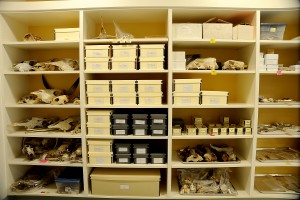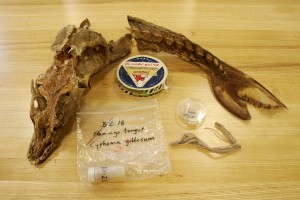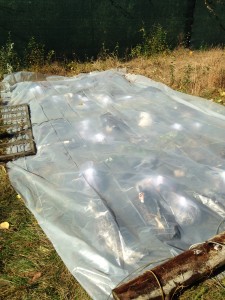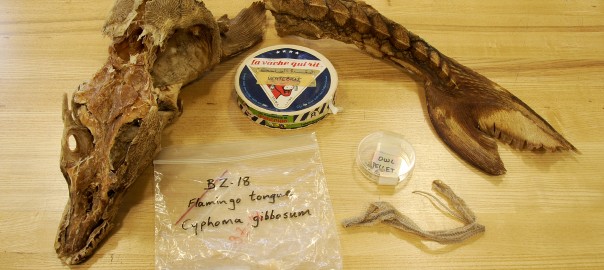My name is Laura Masur and I am a Ph.D. candidate in the Department of Archaeology at Boston University. This year I am managing the Zooarchaeology Lab for my graduate fellowship. I work closely with Professor Catherine West to keep the lab running: this involves working with students who are sorting fauna or researching class projects, facilitating communication among lab members, and making sure collections and archaeological samples stay organized.
 Since fall of 2015, we’ve been working on building the Zooarchaeology Lab’s comparative and teaching collections. This process involves sorting older collections housed in the department, and adding new specimens to the collection.
Since fall of 2015, we’ve been working on building the Zooarchaeology Lab’s comparative and teaching collections. This process involves sorting older collections housed in the department, and adding new specimens to the collection.
We first had to sort the old collections. Some boxes contained complete skeletons that were identified to species. We were able to incorporate these specimens into our comparative collection, in order to identify faunal samples from archaeological sites. Other boxes contained skeletons or crania with missing or non-specific taxonomic identification. Still more boxes contained old archaeological samples without context information. Because we don’t know the provenience or taxonomic identification of these bones, they are most suitable for our teaching collection.
 We also found some pretty wild things in the old collections. Some of our favorites were owl pellets, a mummified mouse, tiny bones stored in cigarette, cream cheese, and Laughing Cow cheese boxes, and a vial labeled “flamingo tongue.” (Never fear: this was not a flamingo’s tongue, but a species of sea snail!) Professor West was partial to the desiccated Sturgeon, wrapped in 1980s newspaper in a gift box.
We also found some pretty wild things in the old collections. Some of our favorites were owl pellets, a mummified mouse, tiny bones stored in cigarette, cream cheese, and Laughing Cow cheese boxes, and a vial labeled “flamingo tongue.” (Never fear: this was not a flamingo’s tongue, but a species of sea snail!) Professor West was partial to the desiccated Sturgeon, wrapped in 1980s newspaper in a gift box.
Over the past few years, we have been working with Professor Jonathan Bethard and Dr. Tom French of the Massachusetts Division of Fisheries and Wildlife to acquire and process new specimens for our comparative collections. These animals met their unfortunate ends of natural causes or under veterinary care, and ended up at the Division of Fisheries and Wildlife in Westborough, Massachusetts. We let nature “render skeletons” for us, and bring the bones back to the lab. Our students and volunteers diligently wash these skeletons, and label them with a zooarchaeology lab or “ZL” number.
 While each specimen in the comparative collection is housed in its own box, the teaching collections are organized by element. This way, students learning a specific element will be able to examine inter-species variations in that element.
While each specimen in the comparative collection is housed in its own box, the teaching collections are organized by element. This way, students learning a specific element will be able to examine inter-species variations in that element.
 We plan to continue this process until we have a good selection of animal species, useful for both research and teaching purposes. Please be in touch if you have animals we could use!
We plan to continue this process until we have a good selection of animal species, useful for both research and teaching purposes. Please be in touch if you have animals we could use!
